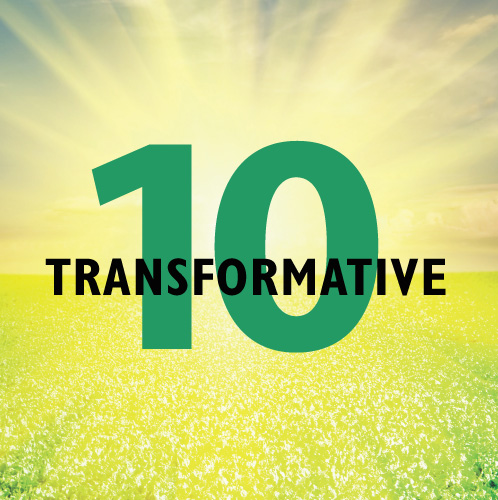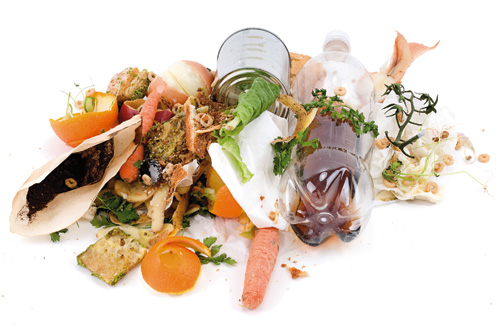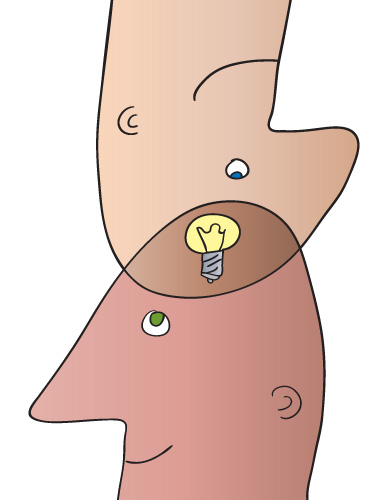 Bigger, greener, cleaner, brighter ideas that will change the world.
Bigger, greener, cleaner, brighter ideas that will change the world.
BY LINDA BAKER
1. FOOT SOLDIERS IN THE SOLAR ARMY
 “Solar energy is one of the most expensive energy sources right now. So every aspect of solar cells is being scrutinized to see how it can become more efficient and cheaper,” says Scott Weaver, chief business strategist at CSD Nano, a Corvallis startup that makes anti-reflective coatings for photovoltaic cover glass.
“Solar energy is one of the most expensive energy sources right now. So every aspect of solar cells is being scrutinized to see how it can become more efficient and cheaper,” says Scott Weaver, chief business strategist at CSD Nano, a Corvallis startup that makes anti-reflective coatings for photovoltaic cover glass.
The Holy Grail for solar energy advocates is grid parity, in which electricity from solar costs the same or less than power from fossil fuels. CSD Nano, which is using nanotechnology based on the anti-reflective retina of a moth eye, is just one of many technology companies working on driving down costs. “It’s very exciting,” Weaver says. “We’re part of manifest destiny.”
Shannon Boettcher, a UO chemistry professor, is another pioneer, although he approaches the problem from a different angle. Solar energy is an intermittent power source, so figuring out how to store energy from the sun and make it a stable reliable energy source is crucial to achieving grid parity, says Boettcher. His research focuses on converting electricity from the sun into chemical bonds such as hydrogen that can be stored for later use. “We know how to do this using expensive exotic materials that are highly engineered. The challenge is to develop a process using earth abundant elements we can put together in low-cost scalable ways.”
An international contingent is working on this approach, Boettcher says. “Because if we want to displace all of our fossil fuel energy use, if we want to stop using coal, then we absolutely have to store renewables.”
2. THE LED ELIXIR
 LED lights are about five times more efficient than conventional incandescent light bulbs. They are also up to 20 times more expensive and lack the warm light typical of the conventional bulb, which keeps consumers from buying them. If everyone transitioned to LEDs, consumers would potentially save 190 terawatt hours annually — the equivalent of lighting over 95 million homes. Pacific Light Technologies, a Portland startup, is developing a new process aimed at mainstreaming the high-efficiency LED. The technology involves quantum dots — chemically created microscopic semiconductors — that provide better light output “tunable to different hues,” says Pacific Light CEO Ron Nelson. The dots, now being tested with major lighting manufacturers, will also reduce the cost of LEDs by at least 50% and enable replacement of the phosphors currently used in LED lights, reducing industry dependence on the rare earth compounds. “We believe we have found the elixir,” says Nelson.
LED lights are about five times more efficient than conventional incandescent light bulbs. They are also up to 20 times more expensive and lack the warm light typical of the conventional bulb, which keeps consumers from buying them. If everyone transitioned to LEDs, consumers would potentially save 190 terawatt hours annually — the equivalent of lighting over 95 million homes. Pacific Light Technologies, a Portland startup, is developing a new process aimed at mainstreaming the high-efficiency LED. The technology involves quantum dots — chemically created microscopic semiconductors — that provide better light output “tunable to different hues,” says Pacific Light CEO Ron Nelson. The dots, now being tested with major lighting manufacturers, will also reduce the cost of LEDs by at least 50% and enable replacement of the phosphors currently used in LED lights, reducing industry dependence on the rare earth compounds. “We believe we have found the elixir,” says Nelson.
3. THE SMARTER FARMER
 In recent years, buying food from your local organic farmer has become all the rage. But most local farmers still struggle to compete against big agribusiness. Smart phones are coming to the rescue, helping small and mid-size farmers practicing sustainable agriculture differentiate themselves from the pack.
In recent years, buying food from your local organic farmer has become all the rage. But most local farmers still struggle to compete against big agribusiness. Smart phones are coming to the rescue, helping small and mid-size farmers practicing sustainable agriculture differentiate themselves from the pack.
“If you’re a medium-size farmer and you’re trying to reposition yourself out of the commodity market, you might tell your distributor you’re certified for environmental stewardship but that story isn’t told to other links in the supply chain. So people are working on Internet technologies to empower farmers to tell what’s unique. You put a QR code on your package and the customer can access the rich information. This is combined with traceability tools that help midsize produce growers satisfy increasing traceability requirements for food safety. It’s about putting tools in the hands of farmers.”
-Scott Exo, former executive director of the Food Alliance, a Portland nonprofit that certifies sustainable agricultural and food-handling practices
4. THE MOBILITY REVOLUTION
 “Reinvent the car.”
“Reinvent the car.”
That’s the 21st century transportation mantra, says Jeff Allen, executive director of Drive Oregon, a public-private partnership supporting the electric vehicle industry. The idea is to move away from the form of a car — four wheels, internal combustion engine, personal ownership — and instead embrace its function of “mostly trying to get around without getting wet or sweaty or carry a bag of groceries.”
On the tech side are Oregon electric vehicle companies Arcimoto, BOXX and Green Lite Motors. These startups are building small-scale motorized scooters or three-wheel vehicles with hybrid or electric engines. The Green Lite system also includes 100 mpg capability and a hydraulic balancing system.
Meanwhile, second-generation (post-Zipcar) car-sharing companies continue to deconstruct car ownership. San Francisco-based Getaround, a peer-to-peer service, allows individual car owners to rent out their own car. Austin-based Car2Go, a smart car-based service, doesn’t require reservations or round trips. Both operate in Portland. Then there is the yet-to-be named vendor for Portland’s bike-sharing program, approved by city council this spring.
Most cars are too big, too expensive and too polluting for the average driver’s needs, car reinvention proponents say. “The transformation you’re seeing is about giving people more reasonable choices for how they travel,” says Jennifer Dill, a PSU urban studies professor and director of the Oregon Transportation Research and Education Consortium.
Even drivers who want a regular old car, just the electrified version, are in for some changes — namely, the kind of battery that will charge that car. “There’s a perpetual race between the things we want our electronics to do and the batteries we have to power them,” says Allen. “It’s a huge driver for the electric vehicle industry.”
One runner in this race is ReVolt, a Portland company developing a zinc air battery that is reusable, recyclable — and energy dense. The goal is to develop a longer lasting more eco-friendly alternative to the commonly used lithium battery, which is susceptible to explosions, depends on toxic metals and lacks sufficient storage capacity to charge a car for long distances.
“Whether it’s a completely new kind of battery or a dramatically better lithium battery,” says Allen, “there’s going to be some kind of a radical transformation.”
5. FUELED BY WASTE
 The United States is home to about 125 biogas plants that convert organic waste to fuel. The majority are in rural areas and rely on animal or plant waste as fuel. John McKinney of Columbia Biogas is developing a $55 million plant in Portland’s Cully Neighborhood, the first in the country to be sited in the center of a metro area. It is expected to be up and running by December 2013.
The United States is home to about 125 biogas plants that convert organic waste to fuel. The majority are in rural areas and rely on animal or plant waste as fuel. John McKinney of Columbia Biogas is developing a $55 million plant in Portland’s Cully Neighborhood, the first in the country to be sited in the center of a metro area. It is expected to be up and running by December 2013.
“This facility is specially designed to handle solid and liquid organic waste streams generated by commercial and industrial waste streams: grocery stores, restaurants, food processors, and beverage manufacturers. Historically a lot of that ended up in landfill, because of plastic or glass or metal packaging. The anaerobic process produces a fuel that will initially power 3,000 homes, and then ramp up to 5,000 homes. What’s unique is the facility also produces fertilizer on the back end. Hauling waste long distances doesn’t make sense.”
-John McKinney founder and president of Columbia Biogas
6. THE LITTLE GREEN SCHOOLHOUSE
 A growing body of evidence links light-filled environmentally friendly schools to improved learning outcomes. The typical portable classroom — there are 129 in the Portland Public School District alone — doesn’t meet the grade, featuring inefficient heating and cooling systems, limited natural light and toxic building materials.
A growing body of evidence links light-filled environmentally friendly schools to improved learning outcomes. The typical portable classroom — there are 129 in the Portland Public School District alone — doesn’t meet the grade, featuring inefficient heating and cooling systems, limited natural light and toxic building materials.
Portland State University architecture professors Margarette Leite and Sergio Palleroni, who are married and are partners in the architecture firm PLDP, aim to create “a healthier greener alternative” to the conventional portable at a cost cash-strapped school districts can afford.
There are other environmentally friendly modular classrooms on the market, says Leite. But most feature expensive technologies. By contrast, their Green Portable Classroom targets simple, cost-effective strategies such as passive ventilation, better window placement and steel frames to eliminate the need for expensive concrete foundations.
Leite says the prototype, which will debut at a Chehalis school this fall, will cost about the same as a conventional structure, about $150,000. It will also cut portable energy use by half, saving schools on electricity costs. “We want to set a basic standard for what we should be providing our kids,” Leite says.
7. THE POWER OF SHARING
 Sharing is on the rise in Oregon. In Portland alone there are organizations that facilitate tool sharing, food sharing, toy sharing, and clothes sharing. But apart from car-sharing companies, few entrepreneurs have figured out how to monetize a model that relies on people not spending money or not buying things. Bright Neighbor, a Portland-based “social network for the transaction of barter,” launching in July, aims to change all that. Oregon Business chats with CEO Arnold Strong and founder Randy White.
Sharing is on the rise in Oregon. In Portland alone there are organizations that facilitate tool sharing, food sharing, toy sharing, and clothes sharing. But apart from car-sharing companies, few entrepreneurs have figured out how to monetize a model that relies on people not spending money or not buying things. Bright Neighbor, a Portland-based “social network for the transaction of barter,” launching in July, aims to change all that. Oregon Business chats with CEO Arnold Strong and founder Randy White.
White: We will be the first mobile peer-to-peer lending app out there. You launch, take a video of that bike in your garage, and suddenly you have a mobile device that makes it easier to inventory things to rent, lend, sell or barter.
OB: How will you monetize the service?
White: Three ways. For those transactions that are rental based, we will take 15%. Another line is a partnership with insurance companies. If you break my John Deere lawnmower, you want it insured. The third item is a transaction on deposit. If someone is going to engage in a sharing behavior, they want to make sure that person is not going to take off with it.
OB: What market niche does Bright Neighbor fill?
Strong: the ability to borrow, lend or trade instead of spending capital is really the market we feel is ready to be unleashed. All of these are ways to unlock value from people’s garages, kitchen shelves, to make sure you’re maximizing value out of everything rather than having it sit in the shed.
8. FOLLOW THE WATER
 International aid organizations typically measure the impact of their clean water or sanitation programs via surveys, which are expensive to execute and often produce inaccurate results. Portland State University engineering professor Evan Thomas, in partnership with Stevens Water Monitoring Systems, has developed a sensor platform (SWEETSense) that will deliver real-time data about the use of water purification filters, high-efficiency cook stoves, and other products used in global development initiatives.
International aid organizations typically measure the impact of their clean water or sanitation programs via surveys, which are expensive to execute and often produce inaccurate results. Portland State University engineering professor Evan Thomas, in partnership with Stevens Water Monitoring Systems, has developed a sensor platform (SWEETSense) that will deliver real-time data about the use of water purification filters, high-efficiency cook stoves, and other products used in global development initiatives.
Since the platform is compact and inexpensive, it can be installed on a large scale, says Thomas, who will deploy the sensors this fall in Rwanda as part of a project distributing water filters to more than 600,000 households. The sensors will measure
usage and performance, allowing aid workers to monitor the effectiveness of the filters and tweak education efforts accordingly.
Lack of access to clean water is one of the major causes of death and disease in Rwanda, says Thomas. “We think this [technology] will lead to significant health improvements.”
9. BETTER LIVING THROUGH GREEN CHEMISTRY
 As the movement to get toxics out of air, water and food migrates to consumer products, green chemistry and “materials management” initiatives are flourishing. Last fall the OSU-UO Center for Sustainable Materials Chemistry received $20 million in funding from the National Science Foundation. This past spring, Gov. John Kitzhaber signed an executive order to invest more resources in green chemistry, including requiring state agencies to develop plans favoring healthy green products in purchasing for electronics, furniture and building.
As the movement to get toxics out of air, water and food migrates to consumer products, green chemistry and “materials management” initiatives are flourishing. Last fall the OSU-UO Center for Sustainable Materials Chemistry received $20 million in funding from the National Science Foundation. This past spring, Gov. John Kitzhaber signed an executive order to invest more resources in green chemistry, including requiring state agencies to develop plans favoring healthy green products in purchasing for electronics, furniture and building.
Such efforts should boost the prospects of companies such as Inpria, a Corvallis company that has developed a water-based process for manufacturing thin film components for the tech industry. The startup was cofounded by Doug Keszler, who is also the director of the Sustainable Materials Chemistry Center. Mainstreaming sustainable materials chemistry requires developing processes and materials that exceed the performance of conventional materials, Keszler says. “If we hit performance, there is a pathway to zero waste.”
Here are a few other initiatives aimed at helping sustainable chemistry and materials researchers along with product manufacturers meet environmental and performance targets more quickly.
A green electronics registry:
Launched in 2006, EPEAT (electronic product environmental assessment tool) rates electronic products based on a variety of lifecycle factors, then connects institutional purchasers to the preferable choice. EPEAT operates in 42 countries and is growing geographically. It covers computers, laptops, imaging devices and is expanding into printers, televisions and servers. EPEAT works with large purchasers to include EPEAT in contracts for “hundreds of thousands of products,” says Robert Frisbee, who was hired this past spring as EPEAT’s first CEO. “Then you get a snowball effect where producers see the market exists and focus on making more efficient products.” In 2007, less than 10% of EPEAT-rated products attained a gold standard; now it’s 50%. Over their lifetime, compared to products that did not meet registry criteria, EPEAT-rated products purchased in 2010 will reduce the use of primary materials by 15.7 million metric tons and use of toxic materials by 1,156 metric tons.
Oregon DEQ’s 2050 Vision:
Since 2009, Oregon has required electronics manufacturers to provide free recycling for televisions, computers and other electronics. Although the program has been hugely successful — 26 million pounds were recycled in 2011 — it doesn’t address the design, manufacturing or consumption of those products. Now the Department of Environmental Quality is putting together an ambitious new plan called the “2050 Vision for Materials Management.” A work in progress, the 2050 vision shifts the focus from managing waste materials and products (such as electronics) at the end of their life to addressing their lifecycle impacts. The goal is a closed-loop system in which all materials are reused.
The Living Building Red List:
The list covers toxic chemicals and materials to avoid in buildings and materials and is part of a push to make healthy products part of green building. Google adopted the Red List last year for all new office construction, a move that will encourage “more manufacturers to reformulate their products to be less toxic,” says Jason McLennan, author of the Living Building Challenge.
10. IN THE END, JUST DO IT
 The green revolution is often framed in terms of the Next Big Thing — the silver bullet that will eliminate greenhouse gas emissions, reduce energy consumption and improve human and environmental health. But at least in the green building and smart-grid sectors, it’s the human factor — not the technology — that may be holding us back.
The green revolution is often framed in terms of the Next Big Thing — the silver bullet that will eliminate greenhouse gas emissions, reduce energy consumption and improve human and environmental health. But at least in the green building and smart-grid sectors, it’s the human factor — not the technology — that may be holding us back.
“For whatever reason in our culture we are always looking for that magic technology to save us and all we need to do is invent the box. But that attitude often gets used as a crutch. Really the trick is knowing how to properly put together buildings with proven technologies, like passive design. That’s the sort of innovation we should focus on. We can do this now.”
-Jason McLennan CEO of the Northwest-based Cascadia Green Building Council, author of the Living Building Challenge
“Smart grid technology is interesting but for the most part we’re applying technology that already exists; we’re using radio waves to carry the application. Smart meters aren’t rocket science, they just aren’t cool. There is some innovation in terms of new standards. The biggest challenge to implementing the smart grid is not the technology but the basic statutory, regulatory and structure of industry. Just in the Northwest we have 40 or 50 utilities that serve [the grid] and all operate it with their own boards.”
-James Materco-founder, director of California-based Quality Logic; founding board member, Smart Grid Oregon


